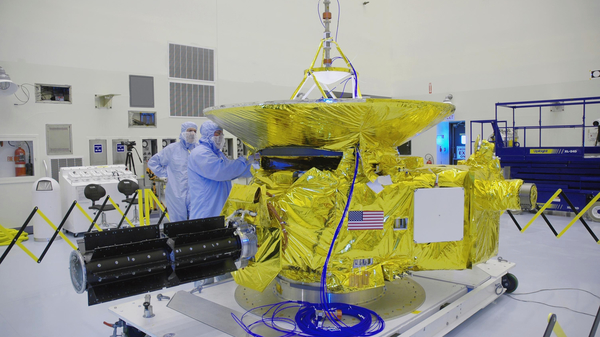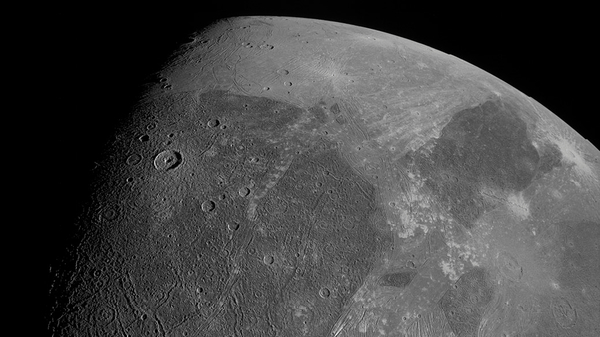What Is the Solar System?
The solar system includes the Sun and everything that orbits it: planets, dwarf planets, moons, rings, asteroids, comets, and particles of dust.

The solar system model is being updated by spacecraft like New Horizons.
©NASA
Where on the Moon is the South Pole?
Solar System Formation
The solar system is located in one of the spiral arms of the Milky Way galaxy. It was born about 4.5 billion years ago when a cloud of interstellar gas and dust collapsed. Most of the material was pulled toward a central point: nearly all of the solar system’s mass—99.8%—is in the Sun.
The rest of the material formed a spinning disk around the Sun. Over time, this gas and dust clumped together to make larger and larger bodies, which eventually became planets, and other objects that orbit the Sun. This process is called accretion.
How bright is the Sun on other planets?
Two Kinds of Planets
The biggest planets were formed from gases and icy materials in the cooler, outer part of the dusty disk. There are four of these giant planets or outer planets: Jupiter, Saturn, Uranus, and Neptune.
In the warmer part of the disk closest to the Sun, smaller planets were formed from rocks and metals. The four terrestrial planets or inner planets are Mercury, Venus, Earth, and Mars.
Another way of classifying planets—from the perspective of Earth—is to say that Mercury and Venus are inferior planets, because their orbit is closer to the Sun. The other planets can be termed superior planets.
Interview: What do we know about spacetime?
There Are Also Dwarf Planets
Some bodies orbiting the Sun have become big enough for gravity to have given them a round shape, but they have not cleared away all the other objects lying close to their orbit.
These bodies are known as dwarf planets. The most famous example is Pluto.
Most Planets Have Moons
There are around 400 known moons in the solar system. The technical term for a moon is a natural satellite. (A satellite is a small body that orbits a larger one; the International Space Station, for example, is an artificial satellite.)
Only three of these moons are found in the inner solar system. Mercury and Venus have no moons, Earth has one, and Mars has two. Most of the other moons orbit one of the outer planets. The two largest moons—Jupiter’s Ganymede, and Saturn’s Titan—are bigger than the smallest planet (Mercury).
Dwarf planets can also have moons. Pluto, for instance, has five.

This close-up photo of Jupiter’s moon Ganymede was taken by NASA’s Juno spacecraft in June 2021.
©NASA
Planets Can Have Rings, Too
In addition to having lots of moons, the four outer planets have ring systems made of dust and ice. Saturn has the biggest and brightest rings, which were first observed in 1610 by Galileo.
Jupiter, Uranus, and Neptune also have rings, although these were not discovered until the late 20th century.
Rocky Regions
The process of accretion does not inevitably lead to planets. Between Mars and Jupiter, there is the asteroid belt. An asteroid is a small rocky object that orbits the Sun.
Some of these rocks have clumped together to form quite large bodies, such as Ceres, a dwarf planet. However, the gravitational effects of Jupiter and Mars mean that the asteroids have not managed to form one single planet.
Similarly, the Kuiper Belt, which lies beyond Neptune, contains billions of icy rocks of various sizes. The largest object in the Kuiper Belt is Pluto. Neptune’s gravity has prevented these objects from merging into a solitary body.
Where Do Comets Come From?
Astronomers think the Kuiper Belt is one of two places in the solar system that comets come from. The other is the Oort Cloud (see below). Comets are small, icy bodies that have highly elliptical, or oval-shaped, orbits.
At one end of the oval, the comet passes close to the Sun; as it heats up, it can produce a distinctive tail of gas and dust. The brightest—and best known—comet is Halley’s Comet, which orbits the Sun about once every 76 years. Halley’s Comet will return to our neighborhood in 2061.

Comet McNaught is seen over the Pacific Ocean in January 2007.
©ESO/Sebastian Deiries
Comets Give Us Shooting Stars
As they pass around the Sun, comets leave behind a trail of dust particles. When the Earth passes through these trails at certain times of year, meteor showers are produced as the particles burn up in the atmosphere. The popular name for a meteor is a shooting star.
Halley’s Comet, for instance, is responsible for the Eta Aquarid meteor shower in April/May, and the Orionids in October/November.
Will you be able to see the next meteor shower?
And What Else...?
Astronomers speculate there may be more things beyond the Kuiper Belt that are part of our solar system. These speculations include a possible ninth planet, which is sometimes referred to as Planet Nine or Planet X. At the moment, however, there is no direct evidence that such a planet exists.
Another possibility is that there is a spherical shell of icy rocks lying at a huge distance from the Sun—about one third of the way to the nearest star. Known as the Oort Cloud, this could be the source of long-period comets.
A long-period comets can take many thousands of years to orbit the Sun, whereas a short-period comet generally takes less than 200 years. Although Halley’s Comet is a short-period comet, astronomers believe it might originally have been a long-period comet that came from the Oort Cloud, and had its orbit affected by a giant planet.